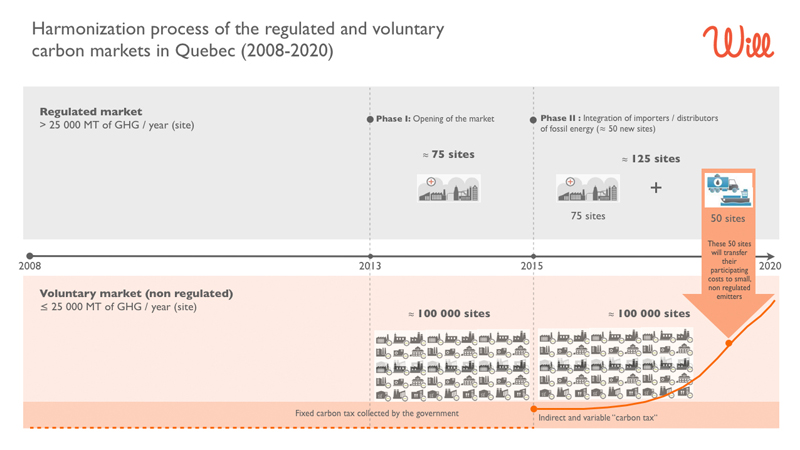The voluntary carbon market, which is not regulated in Quebec, targets overall small final emitters (SFE) that emit less than 25 000 tons of GHG yearly.
The voluntary carbon market, which is not regulated in Quebec, targets overall small final emitters (SFE) that emit less than 25 000 tons of GHG yearly. This market is made up of more than 99 % of buildings in the Industrial, Commercial and Institutional sectors. Since January 1st 2013, the regulated market is governed by the « Système de plafonnement et d’échange de droits d’émission de gaz à effet de serre du Québec (SPEDE) » and targets large final emitters (LFE) emitting more than 25 000 tons of GHG yearly. Their contribution represents about 25 % of all of Quebec’s GHG emissions.
This regulated market (SPEDE) will be deployed in two phases:
- Phase I, from 2013 to 2015, during which about 75 direct participants will be governed by the SPEDE.
- As soon as phase II begins, in January 2015, 50 more participants will be added (importers and distributors of fossil energy govern by article 2.2 of the SPEDE) for a total of 125 direct participants governed by SPEDE.
After phase II, about 85 % of Quebec’s GHG emissions will be governed by the SPEDE. The participants governed by the SPEDE will have the obligation of reaching yearly GHG emission thresholds (ceilings) to respect.
The impact of the deployment of the second phase of the SPEDE on Quebec’s economy is not yet known. Some distributors and importers of fossil energy have already indicated that they will transfer their SPEDE participating costs to their customers. Therefore, significant increases in the prices of fossil energy for all of Quebec’s economy are to be expected, including an increase in the prices of gas at the pump as soon as 2015.
This increase will be variable and unpredictable during the 2015-2020 period, as indicated in the orange section of the following schedule. The transfer of the participating costs of distributors and importers of fossil energy governed by the SPEDE to their customer base (thousands of small final emitters of GHG) would be exponential.


